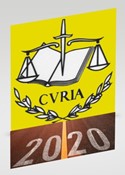
Here‘s a look-back on the year that is about to end, with a promise not to say anything about Covid, Brexit, or Trump!
This is about CJEU rulings in 2020 concerning appeals filed in trade mark matters – some numbers and observations – and wishes for 2021!
The total number of CJEU rulings in such matters in 2020 was 51 (not counting 4 design cases and two procedural cases that had nothing to do with trademark matters). In three cases, there was no need to adjudicate as the parties settled or the appeal was withdrawn. So that leaves 48 decisions.
Of these 48 decisions, 35 were orders and 13 were judgments. The 13 judgments all concerned cases lodged before 1 May 2019. Some of them contributed significantly although perhaps not always positively to the development of EU trademark law. None of them would have been handed down had the appeals been lodged after 1 May 2019, but more on this below.
Let’s look first at the Court’s orders:
In one case (C-174/20), the appeal was inadmissible as filed too late. The time limit is two months, plus an extension of 10 days (as in all GC and CJEU cases). The original two-month time limit fell on a weekend so the appellant calculated the 10-day extension from the following work day. That was wrong – extensions of time must be calculated from the original end of the time limit.
In another case (C-455/18 P), the CJEU confirmed that representation before the EU courts requires that it is somebody else that represents the appellant. An attorney cannot represent himself. The corresponding GC finding was correct and the appeal manifestly unfounded.
All other 33 orders concerned appeals filed after 1 May 2019. On that date, the changes to the appeal procedure entered into force according to which appellants must now file, within the appeal period and in addition to the appeal brief, a separate maximum 7-page brief requesting the appeal to be allowed. This requires that the issue raised is significant with respect to the unity, consistency or development of EU law. The hurdle is high. Or very high. In fact it is so high that since 1 May 2019, not one single appeal has been allowed.
Now, of the 33 orders in 2020, 3 dismissed the appeals as inadmissible; in 2 cases, no separate request had been filed, and in one case, the request did not comply with formal requirements. Indeed, the CJEU (C-193/20 P) complained that the request had a spacing smaller than required, and that it might have run to more than 7 pages with the compliant 1.5 line spacing…
This leaves 30 cases where appellants argued inter alia that the GC ruling at issue was inconsistent with the case law (most cases), that it concerned issues that arise in many cases (e.g. C‑239/20 P), that the relationship between trademark law and other regulations was unclear (C-400/20 P), or that the legal criteria applied were wrong on a point on which the CJEU had not yet ruled (C‑304/20 P). Yet, the Court was not convinced that any of these arguments had anything to do with the unity, consistency or development of EU law.
It is odd that this general refusal to accept any new appeals coincides with the year in which the CJEU allowed more appeals than ever before: in 7 of the 13 judgments, the appeals were successful. In 5 of these cases, the CJEU even ruled on the substance, rather than just annulling the GC and referring the case back.
These 5 cases were: 27/02/20, C-240/18 P – FACK JU GÖTHE; 04/03/20, C-155-158/18 P, Burlington; 04/03/20, C-328/18 P – Equivalenza Manufactory [BLACK LABEL]; 11/06/20, C-115/19 P, China Construction Bank [CB vs. CCB]; 11/11/20, C-809/19 P, John Mills [MINERAL MAGIC]. [Links lead to earlier blog posts on the judments]
The other two successful appeals were decided on 05/03/20, C-766/18 P, BBQLOUMI, and on 18/06/20, C‑702/18 P, PRIMART.
The other 6 judgments where appeals were dismissed were: 23/04/20, C-736/18 P, Gugler; 18/06/20, C‑142/19 P, PLOMBIR; 16/07/20, C‑714/18 P, TAIGA vs tigha; 03/09/20, C-214/19 P, achtung!; 16/09/20, C 121/19 P, EDISON; 17/09/20, C-449/18 P, MESSI.
There would be something relevant to say about each of the 13 substantive CJEU judgments in trademark appeals in 2020 and it not for nothing that quite a few of them have been covered in earlier posts on this blog. Alas, in the future, we will be deprived of the CJEU’s wisdom. While not always what we would like to see, CJEU rulings do indeed contribute to the unity, consistency or development of EU law. As the GC case law is sometimes widely divergent, one higher instance that rules at least on some substantive issues has always been welcome.
Let’s see if the hurdle will remain insurmountable; if so, it’s bye-bye CJEU on trademarks (and there will be a greater need for national courts referring cases to the CJEU!).
So: fingers crossed for yet another positive change in 2021! Happy New Year to all readers!
_____________________________
To make sure you do not miss out on regular updates from the Kluwer Trademark Blog, please subscribe here.



The appeal system has the advantage that the Court of Justice sees the full picture of a case, not only a question in a case prepared by national courts.
Preliminary rulings, to the contrary, have the advantage of a more concentrated approach on legal questions.
Under the current system it is more difficult to come to the CJEU via the EUTM system than via the national system. A national court always may ask for an interpretation.
It would make sense to change the rules and allow the General Court and the Boards of Appeal to ask preliminary questions to the Court of Justice.